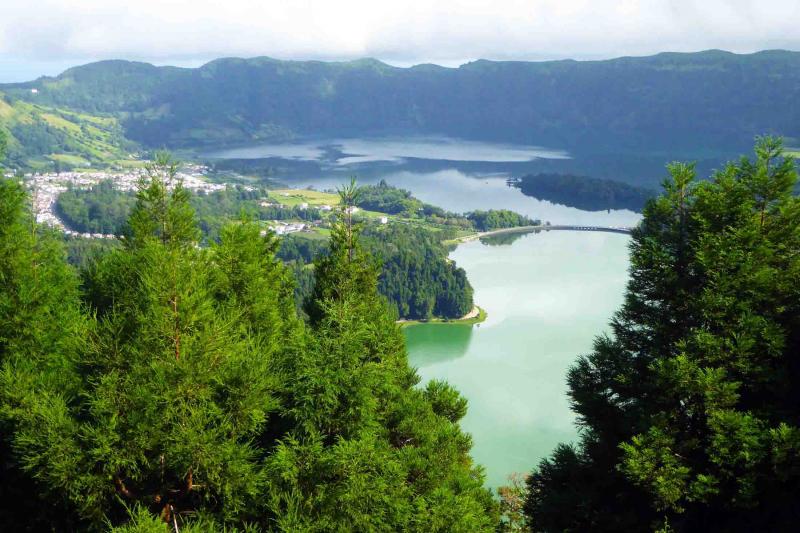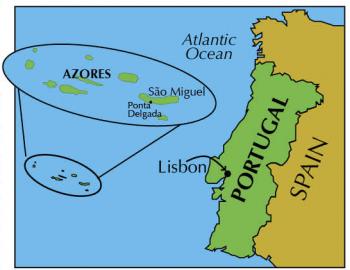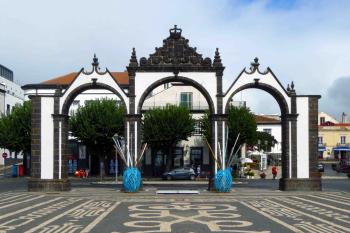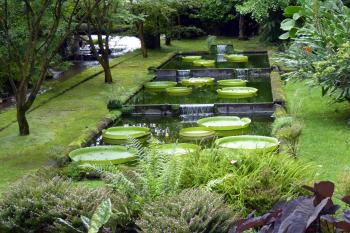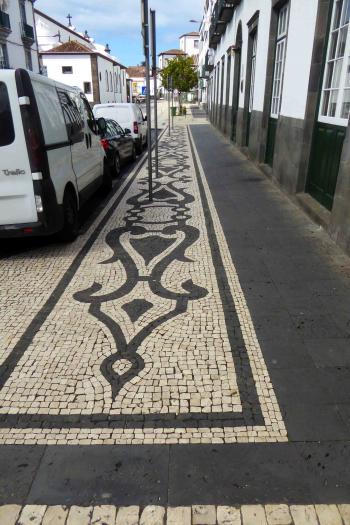Portugal’s amazing Azores
This article appears on page 6 of the February 2022 issue.
International travel has been a significant feature of our professional lives since the first year of our marriage, over 40 years ago. As a humanities professor (Elizabeth) whose focus is the cultural expressions of diverse peoples and a travel photographer (Phil), we have been fortunate to enjoy experiences abroad at least once a year, sometimes more, seeking destinations around the globe that would offer primary material for our work. Studying, learning and documenting propelled us to the far reaches of the globe. However, since March 2020, like most, we have remained largely at home.
With the decline in the number of COVID cases in the spring of 2021, we decided to book a trip to the Azores for Sept. 1, not knowing that the Delta variant would surge in a few months’ time. We thought about canceling in August but hesitated, since our airline tickets were non-refundable. So, despite the regulations and obstacles in place for overseas travel during the pandemic, we went ahead with our plans.
Getting there
We had booked our flight with the Azores airline SATA (US office, 669/292-5454, www.azoresairlines.pt/en), which offered one flight a day from Boston to the island of São Miguel. We flew from our home in Orlando, Florida, to Boston, then boarded our flight around 11 p.m., arriving in the capital city of Ponta Delgada at around 7 a.m. (The overseas flight lasted just under five hours, and there is a 4-hour time-zone difference from Eastern time.)
We had booked separate round-trip tickets with Delta from Orlando to Boston, since SATA has no codeshare partners, at a cost of $372 each, and flew business class on SATA on the outbound flight and economy back ($1,073 round trip each). The only other option was to fly past the islands to Lisbon, change planes and come back to the Azores, with two stops in all, for a total of 22 hours’ travel time and $1,700 each in economy, so purchasing the separate Delta tickets to Boston proved more economical and saved us time as well.
Entry to the Azores at that time required an RT-PCR test to be done within 72 hours of our flight. In our search for testing centers, most needed 72 hours to send results. Fortunately, a CVS MinuteClinic close by promised PCR results in 48 hours at their in-house lab. It was convenient to be able to self-administer the nose swab and then quickly drop it in the solution and hand it through the window at the drive-through. The personnel at the CVS lab were as good as their word, and we received our results (negative) the next day.
Of course, masks were required throughout, and it was gratifying to see most locals in São Miguel wearing masks everywhere, even outside, eliminating our fear of exposure.
Ideal conditions
We had put the Azores, an autonomous region of Portugal, on our list of intriguing destinations a few years ago when we read of the natural beauty and unique geology of this Atlantic archipelago located some 900 miles from Lisbon.
During the pandemic, the islands presented themselves as an attractive option, since they are sparsely populated and the temperate climate of the summer and fall months allow for outdoor activities and experiences. We were not disappointed.
September is an optimal time to visit, with fewer visitors and weather in the low 70s. We enjoyed lots of sunshine, and the occasional downpour was generally over in minutes, leaving rainbows and fresh breezes.
The luxuriant green of the major island of São Miguel, with its unmatched sea views; quaint, immaculate towns and villages; roadways lined with hydrangeas of every shade; volcanic pinnacles and rugged coastlines; a cuisine of fresh fruits and vegetables and seafood, and the friendliness of the people, all contributed to a splendid experience.
We were hosted for a week by an old friend and resident of the Azores, John Court, an internationally known portrait and landscape artist. John has lived in the Azores for over 30 years, and he and his beautiful wife, a native of the island whose family history reaches back centuries to the early period of Portuguese settlement, created our itinerary and provided us with an extraordinary experience beyond our dreams. Their kindness, hospitality and insider knowledge of the island meant that we saw and experienced the best.
Their guest cottage, overlooking green fields with the Azores’ famous Holstein-Friesian dairy cattle below and the sea just beyond, became our luxurious and peaceful abode following days full of exploring the island, enjoying delicious food and meeting warm and fascinating residents of the island.
São Miguel is just short of 40 miles long and 9 miles at its widest, so in a week’s time we were able to experience the rich and diverse offerings of the island.
Stunning landscapes
On our first full day on the island, we enjoyed a taste of what was to come throughout the week as we drove along the hydrangea-lined roadways to the famous Miradouro da Vista do Rei, one of the many spectacular viewpoints on the island.
From the site of the abandoned Hotel Monte Palace, a ghostly shell of its original splendor, we could look down upon the twin lakes of Lagoa Verde (Green) and Lagoa Azul (Blue).
Romantics tell the tale of the tragic lovers, the green-eyed princess and the blue-eyed shepherd, whose tears fed the lakes, but the reason for the different colors actually has to do with the depth of each lake and the reflection of sky and verdant land. Paths and trails make this a perfect hiking destination.
We had a simple but delicious lunch (entrées from $10) and soothing organic local tea at the O Poejo Tea House (Rua da Queiró, 9; quintadaqueiro.com/en/tea-house-o-poejo), located in the little village of Sete Cidades, between the lakes. Traffic was minimal and the roads were excellent, some even four lanes. A scenic wonder seemed to await around every turn, so our drive back to town along the north-side perimeter road did not disappoint.
Ponta Delgada was our frequent hub for eating, shopping, visiting residents and sightseeing. White stucco buildings with basalt trim and a profusion of balconies overlooked the streets and walkways paved with distinctive Portuguese black-and-white mosaics.
Walking was easy along the waterfront and the back streets, where quaint shops and restaurants of every taste could be found.
A friendly neighborhood bistro, A Tasca (Rua do Áljube, 16), became a go-to lunch spot for us. The charm of this very popular spot was amplified by a very friendly staff, and the stone floor and beamed ceiling exuded an old-world ambience. Specialties included octopus, limpets, tuna carpaccio and an array of tapas, including the island cheeses and house-made sausage (entrées from $10). And we highly recommend the cakes for dessert!
In general, food on the island was varied, with an array of Portuguese specialties, but seafood reigned supreme and was always fresh.
Our friends insisted that we experience their favorite seafood restaurant, the charming, rustic, seaside Ponta do Garajau (Rua Federico Moniz Pereira, 9675-137; restaurantepontadogarajau.com), located in the quaint fishing village of Ribeira Quente, a popular spot for whale-watching.
The menu featured a seemingly endless variety of fresh fish, grilled whole and served intact (entrees from $20). Some of the varieties might be unfamiliar to outsiders, so the restaurant created a menu with pictures of the fish on offer, all brought in daily to the docks.
It was there that we tasted cracas, the famous Azorean barnacles — a specialty of the islands and available in late summer and early fall, when the creatures have built enough of a “shell” to harvest. They are boiled in saltwater, chilled and served cold with lemon.
Hot stuff
Driving a northerly route to the eastern part of the island gave us full views of the most dramatic stretch of coastline on the island. Coves, beaches and cliffs rising from the Atlantic created an undulating span of unparalleled beauty.
Along this coastline is the famous tea plantation of Gorreana (gorreana.pt/en), family owned and operated since 1883, with terraces of tea overlooking the Atlantic. This is the oldest tea plantation in Europe.
Touring the plantation offered some of the most spectacular coastline views. We’d recommend following that with a visit to the museum and boutique to sample the different varieties of organic tea.
Continuing along the northern island road, we descended through the interior of the eastern half of the island to the otherworldly volcanic calderas collectively known as Furnas Valley. There, bubbling fumaroles, calderas and geysers throwing sulfurous steam into the air within this dormant volcanic crater created a setting reminiscent of Dante’s Inferno.
But don’t be afraid. In and around the appropriately named town of Furnas, the island’s second-largest town, you can find health-enhancing natural waters to drink, thermal waters in which to relax and heal, and delicious food cooked in the steaming fumaroles to enjoy, from cozido, a local stew made of meat and vegetables, to fresh corn sold on the street.
Not to be missed are Furnas’ famous bolos levedos, delicious, sweet bread that we enjoyed warm from the oven with the island’s famous cheese or with butter and local jam or honey.
The Terra Nostra Garden Hotel (www.bensaudehotels.com/en/terranostragardenhotel) and its botanical garden ($10 entry fee), in the heart of Furnas, offered a chance to experience the area’s fascinating microclimate. There, healing waters may be enjoyed indoors at the spa or outdoors at the mineral-rich geothermal pool.
I dreamed of a luxurious week at the hotel (rooms from $110 per night) eating the local Furnas specialties, indulging in a daily massage, taking the thermal waters, and mystically “forest bathing” in the tropical density of the garden, with trees and plants from every corner of the globe.
The vaporous, verdant atmosphere of Furnas is only one of many enchantments on the island of São Miguel that will lure us back again. Dining seaside with our gracious friends restored our bodies and souls in this bit of earthly paradise. It was all a perfect antidote to the gloom of the pandemic.
Before returning to the United States, we had to get tested for COVID again. We booked an appointment online (www.germanodesousa.com/en) to test at a laboratory in downtown Ponta Delgada, which emailed us the results of our PCR tests the same day for a cost of about $100 each.

